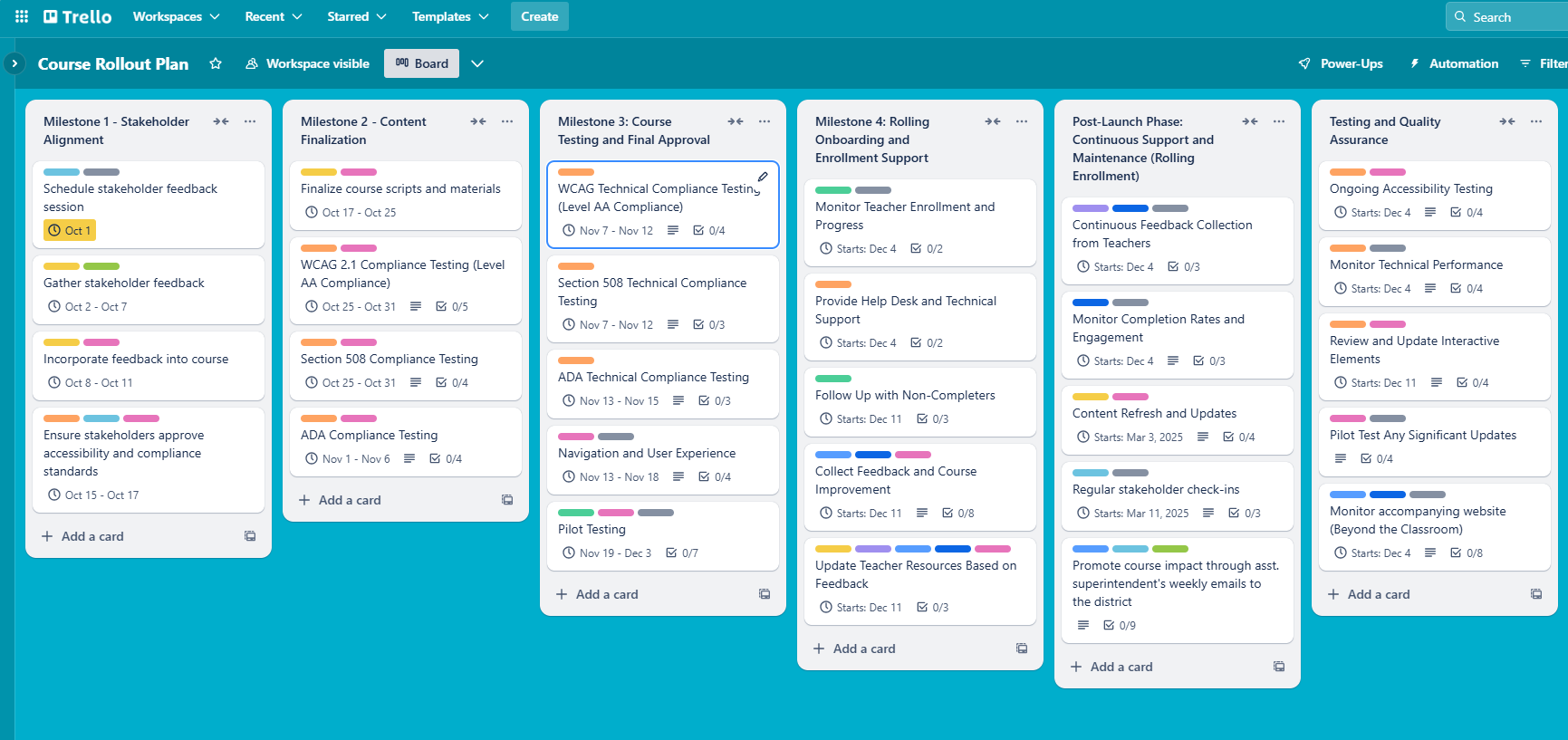
This section outlines my recommendations for launching and sustaining the course, with strategies for staff support, educator engagement, and long-term adaptability. The plan is designed to ensure effective delivery in the home district, while remaining flexible enough for other districts to adopt with minimal adjustments.
Platform Selection
For hosting and managing the professional development course, I selected Eduphoria Strive due to its established use within the district, ensuring seamless integration and a consistent experience for educators. Strive provides a robust platform for tracking required professional development hours, featuring a course catalog with both district and regional offerings, and automates the generation of completion certificates—streamlining record-keeping for teachers and administrators alike.
The platform also supports educators in logging any external training, making it easy to consolidate all professional development hours in one place. In addition to its tracking capabilities, Strive enables goal setting and appraisals, with ongoing progress monitoring and consistent documentation of evaluations throughout the year.
A key advantage is Strive’s integration with other Eduphoria tools, such as Aware, which allows districts to combine professional development data with student information for richer, more actionable insights. This comprehensive approach not only simplifies compliance and reporting but also empowers district leaders to make data-driven decisions and implement targeted improvements based on real outcomes.
Staff and Resources Needed
A successful rollout requires collaboration among key district roles:
Instructional Designer/Developer: Oversees course design, updates, and continuous improvement.
Professional Development Coordinator: Manages enrollment, communications, and reporting.
Systems Administrator & IT/Tech Support: Ensure smooth platform operation and troubleshooting.
Communications Specialist: Shares updates and success stories with educators.
DAEP Admin and Staff: Provide subject matter expertise and ongoing feedback.
Proposed Course Rollout Plan
To support a clear and collaborative launch, I created a visual rollout plan outlining each critical milestone and ongoing quality assurance task involved in implementing the course. The plan breaks down the process into manageable steps, with detailed descriptions, checklists for tracking progress, and embedded resources to ensure accessibility and compliance are addressed throughout. Tasks are organized by responsible team members and color-coded for transparency and efficiency.
This structured approach enables real-time collaboration, rolling enrollment, and continuous improvement as the course is deployed and refined.
You can explore the full rollout plan and see how each phase is mapped out in the resource section at the bottom of the page.
Teacher Engagement and Practical Application
Keeping educators motivated and supported is central to the plan. Key engagement strategies include:
Weekly Newsletter Features: The assistant superintendent’s newsletter highlights teacher success stories, impact metrics, and feedback from the DAEP community—demonstrating the real-world value of the course.
Practical “Lightbulb” Takeaways: A menu button throughout the course offers actionable strategies tailored to each module. The use of this feature is tracked via xAPI data, providing insights into what teachers find most helpful.
Embedded Job Aids and Decision-Making Guides: Teachers have immediate access to tools that simplify curriculum adaptation and support informed decision-making for DAEP students.
Choice-Driven, Exploratory Modules: In Module 3, teachers can explore best practices, technology tools, and classroom strategies at their own pace, personalizing their learning experience.
Social Learning and Resource Sharing
Recognizing that DAEP teachers often lack a dedicated support network, the implementation plan includes a virtual Professional Learning Community (PLC) through the Beyond the Classroom website. Here, teachers can join discussions, participate in polls, and share resources using an embedded Padlet. Contributions are encouraged and rewarded with professional development hours. A dedicated submission form allows teachers to share original materials, which are reviewed by Talent Development and added to the shared resources library—ensuring recognition and ongoing collaboration.
Scalability and Adaptability
The course was intentionally designed for easy adaptation by other districts. District-specific information, such as contact details and curriculum options, can be quickly updated in editable templates. Links to district websites and external resources keep core content relevant, while embedded placeholders and modular content allow for targeted updates without the need for extensive revisions. Supplementary materials and job aids can be edited to reflect changes in policy, staffing, or administration, ensuring the course remains current and sustainable over time.
To support ongoing improvement, I also developed a comprehensive data analysis plan. This framework helps districts measure course impact using both quantitative metrics (like recidivism rates and completion data) and qualitative feedback from teachers and students. For more detail on how data is collected and used to drive refinement, visit the Evaluation page.
Ready to see how impact is measured?
Continue to the next section to explore the course evaluation plan, including data analysis strategies and continuous improvement measures.
Want a closer look at implementation in action?
Check out the course rollout roadmap and the Beyond the Classroom website—two core resources designed to support implementation and build lasting educator collaboration.
A dedicated space for classroom teachers to access tools, share insights, and connect with others supporting students assigned to DAEP—offering practical guidance, community, and resources beyond the traditional classroom.
Step-by-step guide to launching and sustaining the course.
Preview the survey used to gather teacher input and shape ongoing resource development for the project.
See how teachers could submit original resources for peer sharing and PD credit within the implementation plan.

